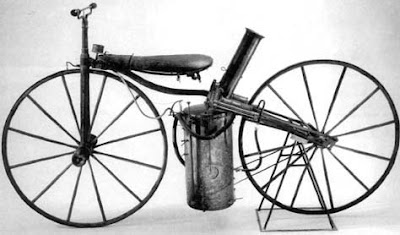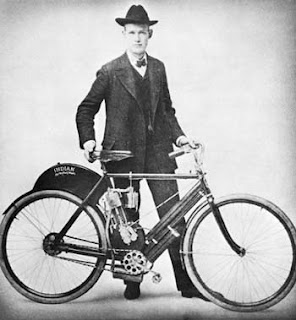 |
| steam velocipede built |
A steam velocipede built by inventor Sylvester H. Roper in 1867 may be the earliest known motorcycle. The coal fired steam engine unit is part of a specially built chassis rather than an add-on and had no pedal crank. While Roper’s two-wheeled inventions never found commercial success, his innovations provided inspiration and direction for inventors in the gas-powered motorbike era at the turn of the century. A steam velocipede built by inventor Sylvester H. Roper was exhibited and demonstrated at New England fairs and circuses by 1869.
 |
| steam velocipede built |
The motorcycle, built in 1884 by an Englishman named Edward Butler, looked pretty silly. It had three wheels, not two, and was really just a tricycle with a motor. Nevertheless, people were afraid of Butler’s motorcycle so afraid that they asked the government to pass laws against the new machine. One law said that there must always be three people on a motorcycle. Another said that a man with a red flag must run ahead of the motorcycle, waving the flag and yelling to warn people that a motorcycle was coming.
At about the same time, a German named Gottlieb Daimler invented another kind of motorcycle. Nicolaus Otto, who invented the Otto Cycle, had an assistant, Gottlieb Daimler. Daimler left Otto to develop his own engine. Gottlieb Daimler (who later teamed up with Karl Benz to form the Daimler-Benz Corporation) is often credited with building the first motorcycle in 1885, one wheel in the front and one in the back, although it had a smaller spring-loaded outrigger wheel on each side. It was constructed mostly of wood, with the wheels being of the iron-banded wooden-spooked wagon-type, definitely a "bone-crusher" chassis.
It was indeed powered by a single-cylinder Otto-cycle engine, and may have had a spray-type carburetor. (Daimler's assistant, Wilhelm Maybach was working on the invention of the spray carburetor at the time). Paul Daimler, Gottlieb’s young son, was the first to give his dad’s motorcycle a test drive. His daughter is also said to have taken it for a spin, but cracked it up into a tree.
He drove it with his engine instead of with a pedal arrangement. But there was a catch: Daimler's motorcycle had two small stabilizing wheels --like a kid's training bike. It was actually a four-wheeled vehicle. Daimler soon went on to build early automobiles. He left it to bicycle builders to develop the two-wheeled motorcycle. The first really successful production two-wheeler though, was the Hildebrand & Wolfmueller, patented in Munich in 1894. In 1897 a gasoline tricycle built by Louis S. Clarke of Pittsburgh, Pennsylvania. This is a remarkably modern-looking tricycle, converted to self-propulsion by the addition of a single-cylinder gasoline engine mounted just forward of the rear axle.
 |
| Oscar Hedstrom |
In 1901, a bicycle racer Oscar Hedstrom designed a motorcycle for the Hendee Manufacturing Company of Springfield, Massachusetts, which later became the Indian Motorcycle Company. In 1903, 21-year old William S. Harley and 20-year old Arthur Davidson made available to the public the first production Harley-Davidson® motorcycle. The bike was built to be a racer, with a 3-1/8 inch bore and 3-1/2 inch stroke. The factory in which they worked was a 10 x 15-foot wooden shed with the words "Harley-Davidson Motor Company" crudely scrawled on the door. The only American motorcycle manufacturer still in existence from the early days is the Harley Davidson Motor Company, which celebrated its centennial in 2003.
EVOLUTION OF MOTORCYCLES
EVOLUTION OF MOTORCYCLES
No comments:
Post a Comment